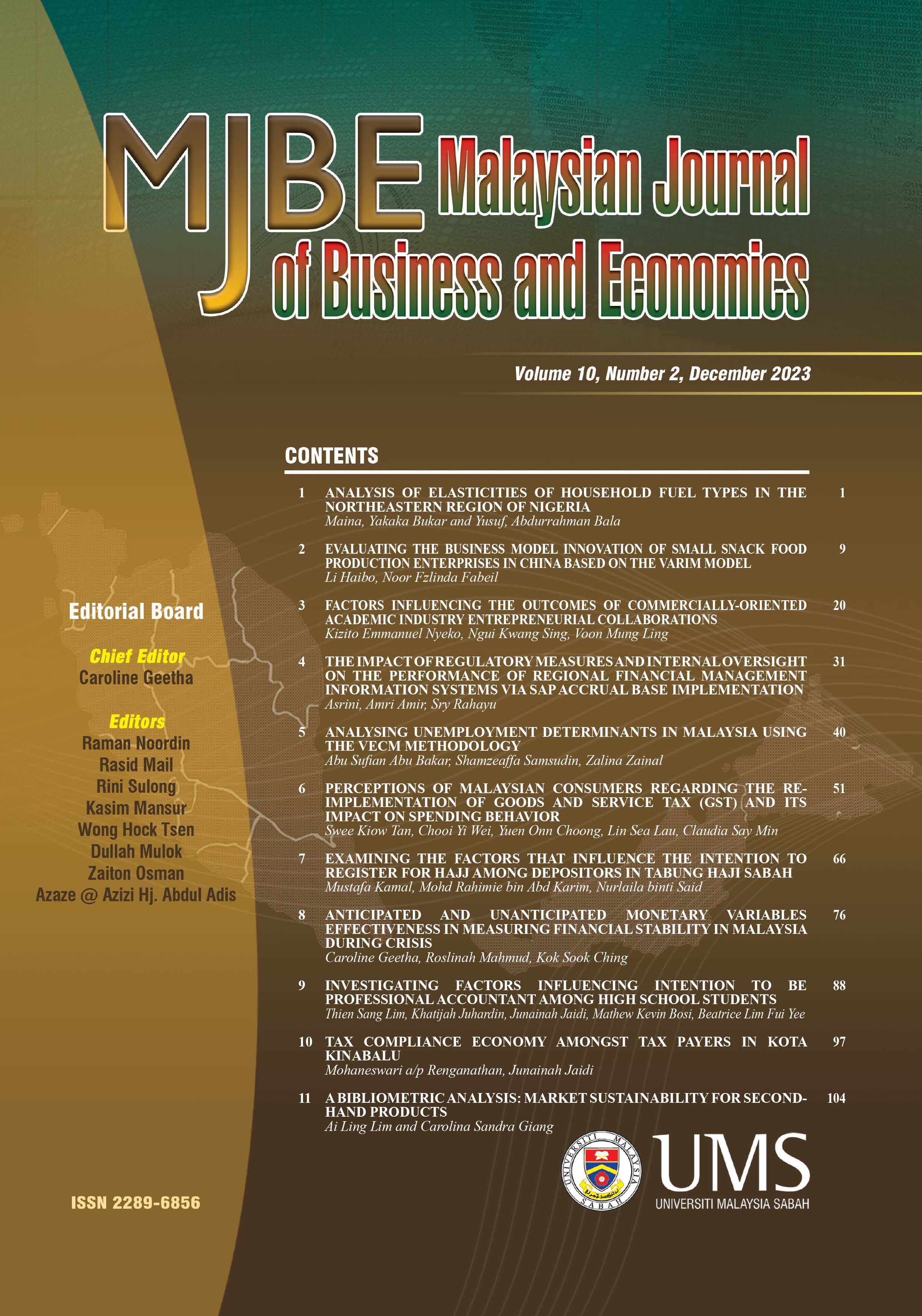ANALYSIS OF ELASTICITIES OF HOUSEHOLD FUEL TYPES IN THE NORTHEASTERN REGION OF NIGERIA
DOI:
https://doi.org/10.51200/mjbe.v10i2.4810Keywords:
household, fuel, elasticity, demand, northeastern region of NigeriaAbstract
Demand for fuel types relies on how low their prices are and the household income. This study used secondary data obtained from the Nigerian Bureau of Statistics General Household Survey (2021) to analyze household fuel demand sources in the North-East Zone of Nigeria. The study used the AIDS model. The results showed that all energy sources except kerosene were comfort goods (elasticities = 1). Kerosene was found to be a necessity (elasticity < 1). This means that households will demand more kerosene if its price falls, but they will demand significantly less kerosene if its price rises. All energy sources were also price elastic (elasticities = 1). This means that households will demand less energy if its price rises, and vice versa. Finally, the results showed that all energy sources had a complementary relationship (negative elasticities). This means that if the price of one fuel type rises households will demand more of other fuel sources. The study recommends that there should be Investment in grid expansion, LPG subsidies, and awareness campaigns for clean energy adoption by the relevant stakeholders which includes government, private, non-governmental organizations, development partners and civic society organizations.
References
Adepoju, A. O., Oyekale, A.S., & Aromolaran, O. (2012). Rural households’ demand for domestic energy in Odeda Local Government Area LGA) of Ogun State, Nigeria.Journal of Human Ecology, 40(2),115-123.
Arthur, S.R., Bond, C., & Wilson, B. (2012). Estimation of elasticities for domestic energy demand in Mozambique. Energy Economics. 34, 398–409.
Bello, M., (2011). Impact of wealth distribution on energy consumption in Nigeria: A case study of selected households in Gombe State. Retrieved from http://www.usaee. org/ usaee2011/submissions/onlineproceedings/1981rs.%20maryam%20bello.%20%20pdf.pdf.
Dilip, A., & Tatsutani, M. (2009). Sustainable energy for developing countries. S.A.P.I.E.N.S2 (1), 1-16.
EIA. (2015) How much energy is consumed in the world by each sector? - faq u.s. energy information administration (eia)] retrieved from http://www.eia.gov/tools/faqs/faq.cfm?id=447&t=1.
Gundimeda, H., & Köhlin, G. (2008). Fuel demand elasticities for energy and environmental policies: Indian sample survey evidence. Energy Economics, 30(2), 517-546.
Kebede B, Bekele A, Kedir E. (2002). Can the urban poor afford modern energy? The case of Ethiopia. Energy Policy, 30(11-12),1029-1045
Maina, Y. B., Kaura, M. M., & Kyari, Bg. (2017). An Empirical analysis of the determinants of households’ energy demand in the northeast region of Nigeria. The International Journal Research Publications. Research Journal of Social Science and Management. 7(7), 40-4 General Household Survey Panel Wave 5. (2019/20). Retrieved from www.nigeriastat.gov.ng>STATAuploads.
National Population Commission (2006). Population May First.Org. (2006). Nigerian Census Figure 2006, Nigeria. Retrieved from http://www.citypopulation.de/php/nigeriaadmin.php.
NBS. (2021) General Household Survey Panel Wave 2. (2019/2022). Retrieved from www.nigeriastat.gov.ng>STATAuploads.
Ogunleye, E. O., & Ayeni, R. K. (2012).Energy Demand in Nigeria: A Disaggregate Analysis International Research Journal of Finance and Economics. 86. Retrieved from http://www.internationalresearchjournaloffinanceandeconomics.com.
Ogunniyi, L.T., Adepoju, A.A., & Olapade-Ogunwole, F. (2012). Household energy consumption pattern in Ogbomoso Metropolis, Oyo State Nigeria. Continental J. Agricultural Economics 6 (1), 10 – 16.
Ojo, C.O., & Chuffor, L. (2013). Accessibility to domestic energy among rural households: A case study of Wagaram Ward of Damboa Local government area of Borno State, Nigeria. Greener Journal of Social Sciences, 3(3),166-170.
Olaleye, S.O., & Akinbode, S.O. (2012). Analysis of households’ demand for alternative power supply in Lagos state, Nigeria. Journal of Social Science 4 (2), 121-127.
Downloads
Published
Versions
- 31-12-2023 (4)
- 31-12-2023 (1)
How to Cite
Issue
Section
License

CCBY (Attribution)
https://creativecommons.org/licenses/by/4.0/
© Universiti Malaysia Sabah 2025
All rights reserved. No part of this publication may be reproduced, distributed, stored in a database or retrieval system, or transmitted, in any form or by any means, electronic, mechanical, graphic, recording or otherwise, without the prior written permission of Universiti Malaysia Sabah Press, except as permitted by Act 332, Malaysian Copyright Act of 1987. Permission of rights is subjected to the journal.









